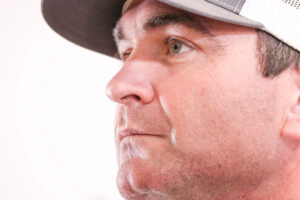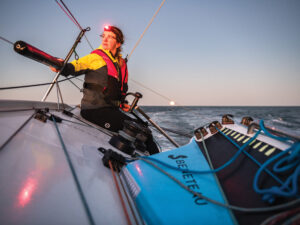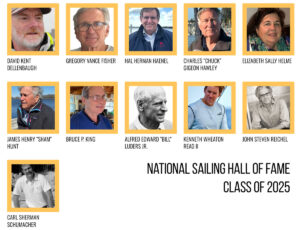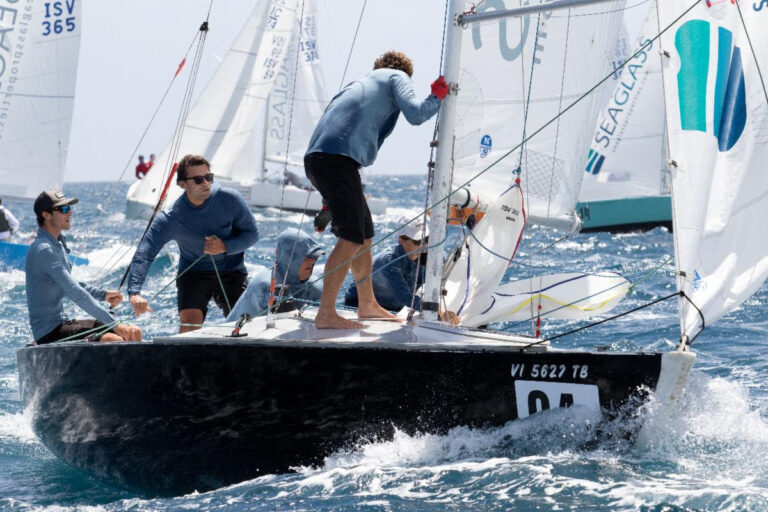
Transitioning from collegiate sailing to keelboats can be difficult for many young-adult sailors who lack experience or connections. It’s not a new problem, and while there are national events and local efforts across the US to retain these young sailors, one program in Rhode Island is having a real and positive impact on the local crew pool.
“You have a lot of people between 18 to 25 that love sailing and maybe do it in college, but then life takes them in different directions, so sailing loses them,” says Peter McClennen, a beneficiary and supporter of Sail Newport’s EOS Sailing Program. “Our view is that college-age sailors don’t really have strong big-boat crew skills. A lot of sailors have never used a winch before and never really worked in anything more than a two-person crew, so we start to introduce the important aspects of teamwork, communication, trim and choreography. We try to have them build two to three role skills so that they can be helpful on other boats.”
Sail Newport’s EOS Program was founded by a group of local sailors in 2017 in honor of renowned big-boat sailor Edward Oliver Sanchez, known for his work ethic and positive attitude. “Tad was always the first one on the boat, the first person down in the bilge bailing it out, and the last person to leave,” says Thomas Loughborough, a professional sailor who coaches with the program. “If you needed a sail moved, he was the first person to jump up and help you move it. The ethos and values of this program were lived by our friend Tad, who was taken from us too soon from bowel cancer in his late 30s.”
With a fleet of donated C&C 30s, the program instructs about 40 sailors, who compete in the local weeknight racing series. To maximize learning and skill-building, the boats are helmed by experienced sailors, and each boat has one professional sailor on board to coach.
“Bringing experienced people onto the boats is a core part of the whole platform,” McClennen says. “We have stable, calm, professional drivers because it’s very hard to train a driver and crew at the same time. If the driver’s wrong, the whole crew’s wrong—that’s just how it works. The crew can’t really be learning if the driver’s not doing the right thing.”
The program’s ethos is that developing the skills of reliability, responsibility and hard work is paramount to preparing young sailors to thrive in keelboat classes. “Teaching resilience is step one; I’m not easy on them,” Loughborough says. “A lot of my coaching has to do with a real focus on the process that is mundane, time-consuming or just uncomfortable, and by that, I mean cold, wet or disruptive to your day. All that preparation before you get on the water is essential to performance on the water.”
Loughborough’s tough-love approach has provided a generation of committed sailors the opportunity to thrive in keelboats. One such beneficiary is Anthony Purcell, a sailor on the University of Rhode Island Sailing Team. “When I heard about EOS, I was all over it,” he says. “I was a freshman in college looking for a way to participate in a highly competitive sport without sailing dinghies.”
Purcell joined the program in the summer of 2021 with minimal keelboat experience. Through working with Loughborough, he developed the skillsets required to be an indispensable member of the programs he now sails with. “The most crucial part of being a program member is showing up—and consistency,” he says. “Tommy was a great mentor because he was able to take me from a timid kid who didn’t know what I was doing to someone with the confidence to say, ‘If I show up and put in the time, there’s no reason things can’t get done.’”

Now in his third year with EOS, Purcell is the program’s fleet manager and the offshore coordinator of the URI Sailing Team who regularly races in IC37 class regattas.
Opportunities for EOS sailors to confidently transition into serious racing programs is the goal, McClennen says. “Once you’re with us and building skills, we’re all pretty well-networked in the sailing community, so as people look for crew, we feed them out. We have people on 12-Meters, IC37s, TP52s, you name it—that’s a key hallmark of our program. If you’re committed and focused on becoming a good sailor, you will get connected and end up on race boats all summer long.”
McClennen’s own IC37, Gamecock, has a crew roster filled with EOS sailors. “My boat has 10 people who have been a part of EOS, as do many of the other IC37s,” he says. “That’s where you see how important those crew skills are. Imagine you’re leading an IC37 campaign and need sailors; an EOS kid can say, ‘I know how to do runners, I know how to do bow, I know how to do mast.’”
Maintaining a fleet of well-used C&C 30s presents a plethora of challenges for the program, Purcell says. “The boats are eight years old, and that’s going to be the limiting factor of the program right now. With old boats, the more you sail them, the more they’ll delaminate and fall apart, and the more things will break.”
It takes a village to keep the boats in working order. With Purcell leading the charge as fleet manager, the sailors take the initiative to maintain the boats and repair damage. Jim Stone, of Gorilla Rigging, donates standing and running rigging to the program and services the boats when needed. Program helmsman Randy Shore, who owns the Newport-based sail loft Sailor and Seam, repairs the sails.
The framework that EOS provides is one solution to the nationwide issue of providing pathways for college sailors and recent grads into adult sailing fleets. The success of any such program, however, depends on the support of boat owners, professional sailors and organizations. For EOS, the connections, capabilities and access to the facilities and staff of Sail Newport, the city’s public-sailing facility, are critical to the effort.
Loughborough believes programs like EOS require three things: generous benefactors, an organization like Sail Newport that is willing to take on the risk and responsibility and, most importantly, a pool of keen young adults who want to move to the next level. “If the community in which you’re trying to create this doesn’t have that level of interest in the sport, then it’s going to be very difficult to get that type of buying and participation from the students themselves,” Loughborough says.
While the program is limited to Newport, its local nature allows for a dynamic environment that adapts to the needs of its sailors. “It’s very motivating to work in this type of program,” Purcell says. “Every time I throw out an idea, Peter is all about it. It’s really awesome that he goes out of his way so much to give everybody as many sailing opportunities as possible, and then repeat those opportunities to anyone who shows commitment to the program. It’s very motivating to know that the time and effort I’m putting in are recognized by those above—not only recognized, but greatly appreciated and often vocalized. It’s great to be a part of a program that I know has enthusiasm and funding.”
The success of EOS over the years confirms at least one thing: Most college sailors want to continue in the sport but lack the connections and skills to do so in big-boat sailing. As long as there is an opening to connect sailors to boats, more will transition from scholastic athletes to participants of a lifetime sport. It’s a model approach that can benefit any fleet looking to increase participation and ensure its longevity.









